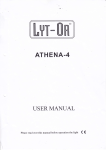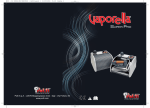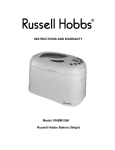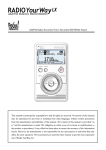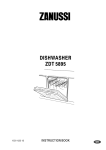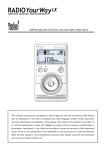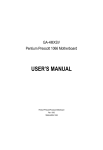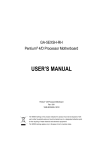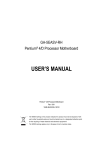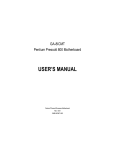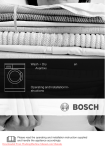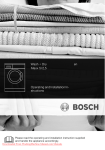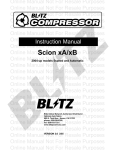Download Electrolux 55750 Dishwasher User Manual
Transcript
ÖKO-FAVORIT 55750 Dishwasher Instructions for Use Dear Customer Please read these operating instructions carefully. Please make sure you read the safety instructions on the first pages of these operating instructions! Keep the operating instructions for future reference. Pass them on to any future owners. With the warning triangle and/or by means of key words (Warning!, Caution!, Important!), information is emphasized which is important for your safety or the correct functioning of the appliance. It is essential that this informa tion is observed. 1. This symbol guides you step by step when operating the appliance. 2. . . . 3. . . . Next to this symbol you receive additional in formation and practical tips on using the ap pliance. Tips and information about the economical and environmentally friendly use of the ma chine are marked with the clover. These operating instructions contain information ab out how to independently solve any problems which may arise. See "What to do if...". This appliance conforms with EC-Directive 73/23/EEC, 90/683/EEC, 89/336/EEC, 93/68/EEC 2 Content Safety Instructions . . . . . . . . . . . . . . . . . . . . . . . . . . . . . . . . . . . . . . . . . . . . . . . . . . . . . . . . . . 4 Description of the Appliance . . . . . . . . . . . . . . . . . . . . . . . . . . . . . . . . . . . . . . . . . . . . . . . . . . 5 General Hints & Tips . . . . . . . . . . . . . . . . . . . . . . . . . . . . . . . . . . . . . . . . . . . . . . . . . . . . . . . . . 6 Prior to Using for the First Time . . . . . . . . . . . . . . . . . . . . . . . . . . . . . . . . . . . . . . . . . . . . . . . 7 The Crockery Basket . . . . . . . . . . . . . . . . . . . . . . . . . . . . . . . . . . . . . . . . . . . . . . . . . . . . . . . . . 9 Filling with Rinse Aid . . . . . . . . . . . . . . . . . . . . . . . . . . . . . . . . . . . . . . . . . . . . . . . . . . . . . . . . . . . . . Setting the rinse aid dosage . . . . . . . . . . . . . . . . . . . . . . . . . . . . . . . . . . . . . . . . . . . . . . . . . . . . . . . . Filling the salt dispenser . . . . . . . . . . . . . . . . . . . . . . . . . . . . . . . . . . . . . . . . . . . . . . . . . . . . . . . . . . . Setting the Water Softener . . . . . . . . . . . . . . . . . . . . . . . . . . . . . . . . . . . . . . . . . . . . . . . . . . . . . . . . The first wash cycle . . . . . . . . . . . . . . . . . . . . . . . . . . . . . . . . . . . . . . . . . . . . . . . . . . . . . . . . . . . . . . 7 7 7 8 8 Cutlery basket . . . . . . . . . . . . . . . . . . . . . . . . . . . . . . . . . . . . . . . . . . . . . . . . . . . . . . . . . . . . . . . . . . . Lower basket . . . . . . . . . . . . . . . . . . . . . . . . . . . . . . . . . . . . . . . . . . . . . . . . . . . . . . . . . . . . . . . . . . . . Upper basket . . . . . . . . . . . . . . . . . . . . . . . . . . . . . . . . . . . . . . . . . . . . . . . . . . . . . . . . . . . . . . . . . . . . 9 10 11 Filling with detergent . . . . . . . . . . . . . . . . . . . . . . . . . . . . . . . . . . . . . . . . . . . . . . . . . . . . . . . . 13 Selecting and starting the program . . . . . . . . . . . . . . . . . . . . . . . . . . . . . . . . . . . . . . . . . . . . 13 Program Chart . . . . . . . . . . . . . . . . . . . . . . . . . . . . . . . . . . . . . . . . . . . . . . . . . . . . . . . . . . . . . . 16 Unloading the crockery basket . . . . . . . . . . . . . . . . . . . . . . . . . . . . . . . . . . . . . . . . . . . . . . . . 17 Cleaning and care . . . . . . . . . . . . . . . . . . . . . . . . . . . . . . . . . . . . . . . . . . . . . . . . . . . . . . . . . . . 18 Remedying faults . . . . . . . . . . . . . . . . . . . . . . . . . . . . . . . . . . . . . . . . . . . . . . . . . . . . . . . . . . . 21 Service & Spare Parts . . . . . . . . . . . . . . . . . . . . . . . . . . . . . . . . . . . . . . . . . . . . . . . . . . . . . . . . 22 Technical Data . . . . . . . . . . . . . . . . . . . . . . . . . . . . . . . . . . . . . . . . . . . . . . . . . . . . . . . . . . . . . . 23 Information for Test Institutes . . . . . . . . . . . . . . . . . . . . . . . . . . . . . . . . . . . . . . . . . . . . . . . . 24 Program display . . . . . . . . . . . . . . . . . . . . . . . . . . . . . . . . . . . . . . . . . . . . . . . . . . . . . . . . . . . . . . . . . Remaining running time . . . . . . . . . . . . . . . . . . . . . . . . . . . . . . . . . . . . . . . . . . . . . . . . . . . . . . . . . . . End of the program . . . . . . . . . . . . . . . . . . . . . . . . . . . . . . . . . . . . . . . . . . . . . . . . . . . . . . . . . . . . . . Safety lock . . . . . . . . . . . . . . . . . . . . . . . . . . . . . . . . . . . . . . . . . . . . . . . . . . . . . . . . . . . . . . . . . . . . . Delay start . . . . . . . . . . . . . . . . . . . . . . . . . . . . . . . . . . . . . . . . . . . . . . . . . . . . . . . . . . . . . . . . . . . . . Correcting or Deleting the Program Selection / Pre-selected Start Time . . . . . . . . . . . . . . . . . . . . . . ECO button . . . . . . . . . . . . . . . . . . . . . . . . . . . . . . . . . . . . . . . . . . . . . . . . . . . . . . . . . . . . . . . . . . . . . Mains power loss . . . . . . . . . . . . . . . . . . . . . . . . . . . . . . . . . . . . . . . . . . . . . . . . . . . . . . . . . . . . . . . . Error message . . . . . . . . . . . . . . . . . . . . . . . . . . . . . . . . . . . . . . . . . . . . . . . . . . . . . . . . . . . . . . . . . . . Internal Cleaning . . . . . . . . . . . . . . . . . . . . . . . . . . . . . . . . . . . . . . . . . . . . . . . . . . . . . . . . . . . . . . . . Re-filling the salt dispenser . . . . . . . . . . . . . . . . . . . . . . . . . . . . . . . . . . . . . . . . . . . . . . . . . . . . . . . . Refilling the rinse aid . . . . . . . . . . . . . . . . . . . . . . . . . . . . . . . . . . . . . . . . . . . . . . . . . . . . . . . . . . . . . Cleaning the large strainer . . . . . . . . . . . . . . . . . . . . . . . . . . . . . . . . . . . . . . . . . . . . . . . . . . . . . . . . . Cleaning the fine strainer . . . . . . . . . . . . . . . . . . . . . . . . . . . . . . . . . . . . . . . . . . . . . . . . . . . . . . . . . . Cleaning the spray arm nozzles . . . . . . . . . . . . . . . . . . . . . . . . . . . . . . . . . . . . . . . . . . . . . . . . . . . . . Cleaning the appliance . . . . . . . . . . . . . . . . . . . . . . . . . . . . . . . . . . . . . . . . . . . . . . . . . . . . . . . . . . . . Appliances with stainless steel outer surfaces . . . . . . . . . . . . . . . . . . . . . . . . . . . . . . . . . . . . . . . . . . Customer Care . . . . . . . . . . . . . . . . . . . . . . . . . . . . . . . . . . . . . . . . . . . . . . . . . . . . . . . . . . . . . . . . . . 14 14 14 14 14 15 15 17 17 18 18 18 18 19 19 20 20 22 3 Safety Instructions The safety aspects of this appliance comply with the accepted technical standards and the applicable safety regula tions. Nevertheless, we consider it our obligation to make you aware of the following safety information: Installation • Any electrical work required to install this appliance should be carried out by a qualified electrician or competent person. • Any plumbing work required to install this ap pliance should be carried out by a qualified plumber or competent person. • This appliance is heavy. Care should be taken when moving it. • It is dangerous to alter the specifications or attempt to modify this product in any way. • Care must be taken to ensure that the appliance does not stand on the electrical supply cable. Child Safety • This appliance is designed to be operated by adults. Children should not be allowed to tamper with the controls or play with the product. • Keep all packaging well away from children. • Keep all detergents in a safe place out of children's reach. • Keep children away from the appliance when the door is open, and take care when closing the door not to trap childrens fingers. Before Use • Check your dishwasher for any transport damage. Never connect a damaged appliance. If your ap pliance is damaged contact your retailer. • Before using your dishwasher for the first time, en sure the voltage and current rating in your home is the same as indicated on the rating plate. During use • Items that are contaminated by petrol paint, steel or iron debris, corrosive, acidic or alkaline chemicals must not be washed in this dishwasher. • Under no circumstances should you open the door whilst the appliance is in operation. Always turn off the appliance before opening the door. • Only use detergent specifically designed for use in dishwashers. • Long bladed knives stored in an upright position are a potential hazard. • Long and/or sharp items of cutlery such as carving knives must be positioned horizontally in the upper basket. 4 • When finished loading or unloading close the door, as an open door can be a hazard. • Isolate the appliance from the power supply and turn off the water supply after use. • Care should be taken when cleaning the bottom door seal and hinge area as any exposed metal ed ges may cut if care is not taken. • This product should be serviced by an authorised Service Engineer, and only genuine spare parts should be used. • Under no circumstances should you attempt to re pair the machine yourself. Repairs carried out by in experienced persons may cause injury or serious malfunctioning. Contact your local Service Force Centre. • In the case of a fault, turn off the appliance, discon nect the appliance from the water supply and con tact your local Service Force Centre. • Never sit or stand on the open door. • If the power supply cable of your dishwasher is da maged, it must be replaced by a cable available from your local Service Force Centre. • The water protection system prevents any water da maged providing: - The dishwasher is connected to the mains sup ply. - The dishwasher is correctly installed. Environmental Information Packaging: All packing materials used are environmen tally friendly and reusable. The cardboard parts are made from recycled paper, and the wood parts are un treated. The plastics are marked as follows: "PE" for polyethylene - e.g. packaging foil "PS" for polystyrene "POM" for polyoxymenthylene Old appliances: When disposing of an old appliance, cut off the power supply cable and remove any door catches, to prevent young children being trapped in side. Contact your local Council or Environmental Health Office to see if there are cycling facilities in your area. Keep this instruction book for future reference and ensure it is passed on to any new owner. Description of the Appliance Dishwasher Cover for spray arm Centre spray arm Upper dish basket (height-adjustable) Setting switch for water softener Coarse strainer Cutlery basket top Lower spray arm Water inlet valve: do not open, do not fill with water Salt container Fine strainer with micro-strainer Curtlery basket Lower basket Rinse aid container Display window for rinse aid Detergent container Rating plate Programme guide Control Panel Pre-rinse Clean Dry Rinse Half load Mains switch Programme end Start time / Remaining time display Programme sequence display Regenerating salt control lamp Clear rinse agent control lamp Economy Stop Program button Pre-rinse, with control lamp Program button Quick, with control lamp Program button Intensive, with control lamp Program button Normal, with control lamp Program button Gentle, with control lamp Delay start button 5 General Hints & Tips To save energy: Items not suitable for dishwashers. • Do not prewash dishes under running water. • Wait until the dishwasher is full before washing a load. If necessary use the rinse and hold button. • If washing a reduced quantity of dishes up to maxi mum of 50% of the capacity, use the half load but ton (1/2). • Always select a wash programme suitable for the type of crockery being washed and to the level of soiling (See Programme Chart). • Follow the detergent dosage recommendations in this instruction book and the detergent manufac turers instructions. Never over dose or under dose. • Ensure the water softener is correctly set. The following items should not be washed in the dishwasher (unless they are sold as dishwasher proof). • Cutlery with wooden or horn handles or glued parts • Bronze cutlery • Saucepans with wooden handles • Aluminium ware • Crystal ware • Leaded glass • Plastic items • Antique or fine decorated china • Tin and copper items • Artistic objects • Wooden board For best washing and drying results • Before loading remove all scraps of food and soak very heavily soiled pots and pans. • Arrange saucepans, cups and glasses etc. upside down. • Tilt items with convex or concave surfaces so the water drains off easily. • Avoid contact between the dishes as far as possible. • Wait a few minutes before removing the dishes; in this way they will be cooler and the drying will be improved. • Empty the lower basket first and then the upper basket; this will avoid water dripping from the up per basket onto the dishes in the lower one. • You will improve drying results by leaving the dish washer door ajar for at least 15-30 minutes as soon as the programme finishes. Crockery that may be suitable: • Earthenware crockery can be washed in the dish washer if the manufacturer has indicated that it is suitable. • Some glazed finishes may fade after frequent ma chine washing. • Silver and aluminium parts tend to discolour during machine washing. • Copper, pewter and brass tend to stain. • A chemical reaction can occur between silver cut lery and stainless steel cutlery. As a precaution do not wash together. • Iron and cast iron objects can rust and stain other items. • Certain types of decoration can discolour when washed in a dishwasher. If in doubt check with the manufacturer of the item. When buying new dishes, ensure that they are dishwas her proof. For best results we recommend the use of Finish detergents, rinse aid and salt. 6 Prior to Using for the First Time Carry out the following steps before using your dish washer for the first time. A Filling with Rinse Aid Rinse aid is automatically added during the last rinse, ensuring thorough rinsing, spot and streak free drying. A If the rinse aid display light is lit on the control panel, open the dispenser by turning the sealing cap to the left. B B Fill with rinse aid up to the "max" mark. Do not ex ceed the maximum container mark of 150 ml. - Close the dispenser. - Remove any spillage to prevent foaming. The rinse aid display light on the control panel will go out. Setting the rinse aid dosage According to the finish and drying results obtained, the rinse aid dosage can be adjusted. Position 1 minimum dosage, position 6 maximum dosage. B The factory setting is level 3. Gradually increase the dosage if there are drops of wa ter or lime spots on the dishes after washing. Reduce it if there are sticky whitish streaks on the dishes. Filling the salt dispenser A Warning! Only use special salt for dishwashers. Other types of salt (e.g., cooking salt) often contain water-insoluble components which can block the water softener and may render it unserviceable. Salt and detergent packages often look very similar. Detergent accidentally poured into the salt dispenser will damage the water softener. Each time you fill with special salt, ensure that you are really holding a salt package in your hand. Fill with salt as follows: A Open the cap of the salt dispenser. B Fill the dispenser with water 7 C Fill with 1 kg of special salt. As a result, approx. 1 litre of water will be displaced. A - Remove salt from around the opening of the dis penser. B - Close the salt dispenser by turning the cap until the stop is reached. - Immediately run the "Pre-rinse"program to wash away any salt residues. Never fill the salt dispenser with rinse aid or detergent! The salt display will go out after 1 or 2 rinse cycles. Do not remove the water feed valve, and do not fill with detergent for any reason. C Setting the Water Softener The dishwasher is equipped with a water softener de signed to remove minerals and salts from the water supply, which would have a detrimental or adverse ef fect on the operation of the appliance. The higher the content of these salts, the harder your water is. The softener should be adjusted according to the hard ness of the water in your area. Your local Water author ity can advise you on the hardness of the water in your area. Adjust the dosage as follows: Turn the setting button using a coin or a screwdriver until the arrow on the knob points to the desired num ber. The arrow must point to a number and the po sition must be engaged positively. Clarke French degrees (°TH) degrees PPM (Parts per Million) Level 0-9 0 - 12,5 0 - 125 1 9 - 18 12,5 - 25 125 - 250 2 18 - 26 25 - 37,5 250 - 375 3 26 - 35 37,5 - 50 375 - 500 4 > 35 > 50 > 500 5 The first wash cycle - When using for the first time, use the Intensive pro gram. 8 4 3 5 2 1 The Crockery Basket Before loading, remove any food scraps. Do not rinse with warm water or use a manual deter gent. The illustration gives you some tips for the op timal loading of your dishwasher. Lower basket Heavily soiled, large pieces of crockery will be tho roughly cleaned in the lower basket. - Pull out the lower basket to its full extent. - Arrange large and heavy pieces of crockery, such as plates, bowls, pots etc., in the lower basket. Cutlery basket without cutlery basket top - Place cutlery in the cutlery basket with the handles downward, except for cutlery very narrow handles, which could penetrate through the cutlery basket and could block the spray arm. - With the top fitted to the cutlery basket, the cutlery no longer touches. All parts are accessible for the water jet. In this way, cleaning and drying of the cutlery is improved. with cutlery basket top Important: Long bladed knives stored in an upright posi tion are a potential hazard. Long and / or sharp items of cutlery such as carving knives must be positioned horizontally in the upper basket. Take care when loading or unloading sharp items such as knives. Removing the cutlery basket top - Press in the clips slightly (A) and remove the cutlery basket top upwards (B). 9 Lower basket Adjustable plate rail, right, 10 piece In order to make optimal use of the space in the lower basket, the plate rails can be set in two positions, in the longitudinal and transverse directions. A - To take out the plate rails, the plate rail grip must be pulled away upwards (A). - The plate rails are then put into the transverse posi tion by fitting them into the longitudinal struts (D) on the lower basket, and then pressing down the plate rail (B) until it snaps into place. The plate rail can be varied sideways (C). Positioning as described above. B D C A Adjustable plate rail insert, 5 piece For deep plates or bowls, a part of the left plate rail can be removed. B - To remove the plate rail insert, the plate rail grip is pulled away upwards (A). - The plate rail insert can also be used instead of the 10-piece plate rail, right (B). B D 10 Hinged plate rail, left For large bowls and pots, the plate rail can be unhin ged. 1 2 Remove the 5 piece plate rail inserts and cutlery basket. Pull the plate rail slightly upwards, and fold down onto the basket base to the right. Important The crosswise plate rack on the front right is optimally suited to small, flat plates with a diameter of 170-210 mm. Upper basket Delicate, smaller pieces of crockery are gently washed in the upper basket. - Pull out the upper basket to the stop. - Arrange the small, light and delicate pieces of crok kery such as saucers, cup's, glasses and tempera ture-resistant plastic parts in the upper basket. Fig. A Adjustable glass holder - For stem glasses, suspend the glass holder in the right-hand position (Fig. A) and fold it up. Fig. B - For high, cylindrical glasses, suspend the glass hol der in the let-hand position (Fig. B) and fold it up. - Glasses can also be placed over the protruding rods (Fig. C). - To unload the glass holder, or if it is not being used, fold it back to the right. Fig. C Adjustable Cup Support Arrange crockery offset on and below the hinged cup support, so that the spray jet can reach all parts. Stem glasses can be suspended from the cut-outs in the cup support. The cup support can be positioned at two different heights. 11 The upper basket is adjustable to the right - Set the upper basket to the desired height, corres ponding to your crockery. Even possible with the upper basket loaded. Raising: - Pull out the upper basket. - Lift up the right side. - Pull forward to the stop, and latch into the upper position. Lowering: - Pull out the upper basket - Lift the right side, and lower into the lower position. Before washing, check that the spray arm can rotate freely. Maximum plate size Upper basket: top position Maximum plate size Upper basket: bottom position ∅ 21 ∅ 19 ∅ 30 ∅ 27 Large plates placed at an angle 12 ∅ 28 ∅ 25 Filling with detergent A Never use hand cleaning liquids or commercial cleaners. Only use commercially-available detergents that are suitable for use in domestic dishwas hers. The detergent dispenser is normally open. MAX If it is closed: MIN B A Press the button downwards, and the dispenser will open. C B Fill the dispenser with detergent according to the instructions of the detergent manufacturer. Only place "tabs" in the detergent dispenser or the cutlery basket in accordance with the informa tion of the manufacturer. C Press the dispenser lid shut. D For warm Pre-rinse program, detergent can also be filled in the dip of the lid. D Selecting and starting the program 1. Push the crockery basket completely in. 2. Fold up the door, and press it shut. The door lock must latch, otherwise the ma chine will not start. 3. Press the mains switch. 4. Press the Half Load button if only half the amount of dishes are loaded. 5. Select one of the programs 1 - 5. Refer to the Pro gram Table. The indicator lamp for the selected programme flashes for 5 seconds before the wash programme starts. Half load Mains switch Economy 6. For a period of 5 seconds it is possible to change to another programme, and also to select the Eco but ton or the Half Load button. After each press of a button, there is a period of 5 seconds during which any corrections can be made. Do not open the door after the program has started! To prevent scolding and damage to units by escap ing steam. 13 Program display The illuminated symbols in the display indicate which phase of the program is currently running. Remaining running time As soon as a program starts, the time remaining lights up in the display field in minutes. This time varies de pending on the loading and temperature of the incom ing water. The display may remain at one time for sevral minutes. It may also jump in time this quite normal, and does not indicate a fault. End of the program The illumination of a "0" in the start delay display and the program end symbol in the program display indi cate the end of the washing program. Safety lock The safety lock prevents an accidental restart after the end of the program. In order to be able to enter a new program, the dishwasher must either be switched off and then on again, or the door must be opened and then closed again. The safety lock is released as soon as only the Programme End symbol is illuminated in the programme display. Delay start The start of the selected program can be delayed bet ween 1 and 9 hours in steps of 1 hour using the Start Time Pre-selection button. - By repeatedly pressing the button, the delay time can be programmed in hours, and will be dis played in the display field. Display: Hours and a small "h". 14 Pre-rinse Drying Cleaning Rinsing Program end A washing program can be selected first, and then the pre-selected start time can be pro grammed, or vice versa. If a pre-selected start time is programmed without a washing program, the programmed time goes out after 5 seconds. After selecting a program, the selection of the start delay must take place within 5 seconds. An activated pre-selected start time will be indicated in the display field by a blinking dot. After the pre-selected start time has expired, the machine starts up the selected program automati cally. Correcting or Deleting the Program Selection / Pre-se lected Start Time Using the Stop button, a running program or the preselected start time can be interrupted or cancelled. Interruption: - Briefly activating the Stop button causes an inter ruption of all programs, and the Stop control lamp blinks. - Activating the Stop button again makes the pro gramming active once again. Cancelling: - Holding down the Stop button longer than 2 se conds deletes the program and the pre-selected start time, and any water present will be pumped out. The Program End symbol in the display lights up as soon as all the water has been pumped out. ECO button The wash temperature is reduced using the ECO button, as a result less energy is consumed during heating up. The economy button can be selected for all wash pro grams. The ECO button should be used in particular when using low-alkali compact cleaners with enzymes. The enzymes produce their full dirt-releasing effect in a temperature range between 40 and 50 °C. Half load Mains switch Economy 15 Duration of programm Drying Rinsing Intermediate Rinse Clean Pre-rinse Program Chart Gentle Light to normally soiled crockery 45°C 65°C 59 min. + ECO Lightly soiled crockery 40°C 60°C 48 min. + Lightly soiled crockery with half load 40°C 60°C 45 min. Heavily-soiled crockery 50°C 68°C 70 min. + ECO The most economical programme for stubborn dirt. Using this programme, AAA performance in accordance with the EN 50242 "Energy Label" is achieved *) 50°C 68°C 2.5 h + Normally soiled crockery with half load ÇÇ ÇÇÇÇÇÇÇ ÇÇÇÇÇÇÇÇÇ Normal Intensive ÇÇÇÇÇ ÇÇÇÇÇÇÇ ÇÇÇÇÇÇÇÇÇÇÇÇ 50°C 65°C 64 min. Very heavily-soiled crockery 47°C 68°C 73°C 86 min. + ECO Heavily to very heavily-soiled crockery 40°C 63°C 68°C 81 min. + Heavily to very heavily-soiled crockery with half load 40°C 63°C 68°C 75 min. Very light to lightly soiled crockery 45°C 65°C 44 min. + ECO very lightly soiled crockery 40°C 60°C 38 min. + very lightly soiled crockery with half load 40°C 60°C 34 min. Quick Pre-rinse Wash off cold ÇÇÇÇÇÇÇÇÇÇÇÇ ÇÇÇÇÇÇÇÇÇÇÇÇ Ç ÇÇÇÇÇÇ Ç ÇÇÇÇÇÇ ÇÇÇÇ 5 The programme times and temperatures are intended as a guide only. The actual programme times will de pend an incoming water temperature an pressure *) 16 A = Best energy efficiency A = Best cleaning result Programme with significantly extended drying A = Best drying result Mains power loss In case of a power failure, or a deliberate disconnection to the power supply, all the set values are retained. Error message Start time / Remaining time display Programme sequence display The electronics of the dishwasher can independently recognise and display faults. If a fault occurs, an error code in the display, one of the program control lamps and the Program End symbol in the display will blink. Please note down this error code before making con tact your Service Centre. The error message is deleted by switching off the main switch. Mains switch Error codes and possible causes A = Water tap closed, inlet hose filter blocked C = Drain hose, coarse or fine strainer or sink trap blocked E = Water pressure too low, water tap not completely opened, inlet hose or inlet hose filter is blocked, machine losing water. E2 = Call AEG Service force H = Call AEG Service force L = Call AEG Service force Unloading the crockery basket After the washing program is complete: First unload the lower basket. Then unload the upper basket, so that no drops of wa ter fall onto the dry crockery in the lower basket. Inspect the coarse strainer after every washing sequence. Clean as necessary. 17 Cleaning and care Internal Cleaning Ensure that the seals around the door, the detergent and rinse aid dispensers are cleaned regularly with a damp cloth. We recommend the use of Finish Dishwasher Cleaner, every 3 months or run a 65oC wash without dishes using detergent. Regular use of Finish Dishwasher Cleaner cleans inaccessible parts, eliminates unplea sant food odours and helps prevent the build-up of li mescale. Re-filling the salt dispenser Never fill the salt dispenser with rinsing aids or detergents! When the salt replenishment lamp lights up, you must refill the special salt for the water softener. Proceed as described in the "Using for the First Time" chapter, however you do not need to add any water during this process. Immediately after refilling, run the "Pre-rinse" program to wash away any salt residues. Refilling the rinse aid When the rinse aid light on the control panel lights up, you must refill with rinse aid. Proceed as described in the "Using for the First Time" chapter. Immediately remove any spilled rinse aid, as otherwise foaming could occur. Cleaning the large strainer Check the large strainer after every cleaning run. Clean as necessary. - The large strainer can be simply pulled out and be re-installed. - Clean the strainer under running water. 18 Cleaning the fine strainer The fine strainer must be cleaned from time to time: - Unlock the strainer by turning it to position A, lift out the fine strainer and clean it under running wa ter with a brush. - Place the strainer in its holder and secure it by tur ning to position B. Cleaning the spray arm nozz les A B Regularly check the nozzles on the three spray arms for blockages. If necessary, clean out the nozzles with a fine wire or a fine pin and a strong jet of water. Take care not damage the nozzle openings. Roof spray arm Remove the roof spray arm: - Loosen the securing screw (A) by turning to the left. - Pull the spray arm from the shaft. - Clean the spray arm and the securing screw. - Refix the spray arm with the securing screw (A) by turning to the right. A B Central spray arm - Remove the central spray arm by turning it to the side, and hoisting off. The two-part spray arm bearing is held together by a clamping spring (B). - To re-install, press the central spray arm upwards until you can feel it locking into place. Lower spray arm Remove the lower spray arm: - Loosen the nut (C) by turning it to the left C - Pull the spray arm from the shaft - Clean the nozzles - Refix the spray arm with the nut (C) by turning to the right. 19 Cleaning the appliance Clean the outer surfaces of the machine, and in parti cular the control panel, regularly using a soft, damp cloth. Only use neutral detergents (e.g., hand washing liquid), but not scouring agents or solvents such as ace tone, paintbrush cleaner or thinners etc. Appliances with stainless steel outer surfaces For the stainless steel front, we recommend thorough and regular care and cleaning with suitable stainless steel cleaners. Pay attention to the instructions regarding detergents and care products. Do not use abrasive or scouring agents. Before wiping, apply the detergent to a damp cloth, clean the surfaces with it, and dry with a clean cloth. When cleaning, ensure that the stainless steel surface finish (the fine diagonal lines) is not worked against the grain: no circular movements! 20 Remedying faults Certain problems are due to lack of simple maintenance or oversights, which can be solved easily without calling out an engineer. Before contacting your local Service Force Centre, please carryout the checks listed below. Important: If you call out an engineer to a fault listed below or to repair a fault caused by incorrect use or installation a charge will be made even if the appliance is in guarantee. The drain pump runs continually even when the ap pliance is switched off. - The water protection system has been triggered. First close the water taps, and then pull out the mains plug or switch off or turn out the fuses. Call AEG Service Force. The program does not start. - Are the fuses of the fixed installation in order? Is the appliance connected to the electrical supply? - Has the door been properly closed? Press the door shut until the door lock latches in. - Has the pre-select start time been set? The machine does not fill with water. - Is the water tap completely open? - Is the water tap blocked? Open and close the water tap several times. - Is the strainer in the hose fitting to the water tap blocked? Clean the strainer if necessary. - Is the inlet hose kinked? Check the hose run. - Is a minimum water flow pressure of 1 bar availa ble? The program sequence display remains static at the start of the cleaning - Is the water tap completely open? - Is the strainer in the hose fitting at the water tap blocked? Clean if necessary. The water is not pumped away - Is the drain hose kinked? Check the run of the hose (see the "Water Drainage" section). - Is the sink drain blocked? Clear any blockages. The crockery is not clean - Have you selected a program that is suitable for the type and degree of soiling of your crockery? (see Program Chart) - Have you arranged the crockery so that the sprayed water has access to all surfaces, both in ternal and external? The crockery baskets must not be overfilled. - Was the spray arm blocked by crockery or pieces of cutlery? - Are the spray arm nozzles clean? - Are all the filters in the bese of your dishwasher clean? Have the filters been installed correctly? - Have you used the correct amount of detergent? Is the drain hose correctly filted. Is the on-site sink drain blocked? Is there salt in the salt dispenser? Without it, the water will not be softened. Lime deposits can form on your crockery and in the machine. - Has the water softener system been set to the local water hardness? The crockery is not dry, and has no sparkle. - Is there rinse aid in the dispenser? - Has the salt dosage been correctly set? Glasses and dishes have streaks, stripes, milky blot ches or blue-coloured bloom. - The rinse aid is being overdosed. Set a lower rinse aid dosage Glasses and dishes have dried-on "water drops". - The rinse aid is being underdosed. Set the rinse aid dosage higher. - Is the lid of the salt container properly closed? Rust marks can be seen in the washing area. - The dishwasher interior is made of stainless steel. Rust marks inside the dishwasher are caused by external rust (rust particles from the water pi ping, from pans, cutlery etc.). Remove such marks using a commercially-available stainless steel cleaner. - Was the "Pre-rinse" program started immediately after refilling the salt? Error codes and possible causes A = Water tap closed, inlet hose filter blocked C = Drain hose, coarse or fine strainer or sink trap blocked E = Water pressure too low, water tap not completely opened, inlet hose or inlet new filter is blocked, machine losing water. E2 = Call AEG Service force H = Call AEG Service force L = Call AEG Service force 21 Service & Spare Parts If you wish to purchase spare parts or require an engi neer, contact your local AEG Service Force Centre by telephoning: 08705 929929 Your telephone call will be automatically routed to the Service Centre covering your post code area. When you contact the Service Centre they will need the following information: 1. 2. 3. 4. Your name & address, including post code. Your telephone number. Clear and concise details of the fault. The model, serial and production number. (This information can be found the rating plate). In order that you have this information to hand when you call, we recommend you write the information below. Product No: ......................................................................... Serial No: ............................................................................. Model No: ............................................................................ 5. Date of purchase. Please note that it will be necessary to provide proof of purchase for any in guarantee service call. Inguarantee customers should ensure that the chap ter headed `Remedying Faults' has been read, as the en gineer will make a charge if the fault is not a mechani cal or electrical breakdown. Customer Care For general enquiries concerning your AEG appliance or for further information on AEG products please con tact our Customer Care Department by letter or tele phone as follows: Customer Care Department AEG Domestic Appliances 55-77 High Street Slough Berkshire SL1 1DZ Tel: 08705 350350 22 Serial Number Prod–Nr.: Serie–Nr.: Mod: Modell Technical Data Dimensions Width Height Max. depth Max. depth with open door Operational voltage Frequency 54.6 cm 75.9 cm 57.0 cm 114.5 cm 230 V 50 Hz Power consumption Circulation pump 150 W Power consumption Heating elements 2000 W Total power 2150 W 10 A Mains water pressure Cold or hot water up to max. 65 °C min. max. 1 bar (flow pressure) Capacity Half load (1/2) *Standard place settings IEC *Standard place settings IEC 11 10 bar 6 Consumption Intensieve Intensieve + Eco Intensieve + 1/2 Energy (kWh) 1,6 1,3 1,13 Water (l) 16 16 15 Normal Normal + Eco Normal + 1/2 1,0 1,0 0,9 16 15 15 Quick Quick + Eco Quick + 1/2 1,0 0,8 0,7 14 14 12 Gentle Gentle + Eco Gentle + 1/2 1,0 0,8 0,7 14 14 12 * A standard place setting consists of: 1 soup bowl, 1 flat plate, 1 dessert plate, 1 saucer, 1 cup, 1 glass, 1 knife, 1 fork, 1 soup spoon, 1 dessert spoon, 1 tea spoon. 23 Information for Test Institutes Prior to the tests, the salt container for the water softener and the rinse aid container must be completely full. Test standard: EN 50 242 Comparison program: Normal + Eco Capacity: tings 11 standard place set Detergent dosing: 27,5 g in the detergent container Rinse aid dosing: setting 6 Loading example: Flat plates Oval plates Dessert plates Soup plates Soup plates 1-10 11 12 13-23 24 24 Soup spoons Serving fork Soup spoon Forks Sauce ladle 25-35 36-37 38-48 49-59 Knives Serving spoons Dessert spoons Tea spoons Dessert plates Installation Instructions UK Any electrical work required to install this appliance should be carried out by a quali fied electrician or competent person. Any plumbing work required to install this appliance should be carried out by a quali fied plumber or competent person. • The dishwasher is delivered ready for connection, i.e. with power supply cable, drain hose and inlet hose with fitted filter and seal. ECO 65˚ 70˚ STOP 45˚ 86 - 91 cm • The installation should be carried out to connec tions provided in a neighboring cupboard (not di rectly behind the unit). ÖKO_FAVORIT 45˚ • The regulations of the local water and electricity companies must be complied with. Water Supply Connections • The dishwasher must be plumbed into a cold water supply. • The water pressure must be within the limits given in the technical specifications. Your local Water Au thority will advise you on the average mains pres sure in your area. • A shut-off device with a ¾" connection must be provided on site. 600 • The inlet hose has a filter to remove any impurities from the water supply and a rubber seal. When fit ting ensure that the filter and seal are correctly po sitioned. 510 No water must escape from the fitting after the shut-off device has been opened. Water outlet hose connection • Ensure the drain hose is not bent or squashed as the could prevent or slow down the discharge of water. • The outlet hose should be connected to a water outlet provided in a neighboring cupboard (not di rectly behind the unit). 574 546 762 759 550 570 • The dishwasher is fitted with a device to prevent the back flow of water, which allows the installation height of the unit to be above the outlet height. • The highest point of the drain hose should never ex ceed the unit height. AEG 153 0409 20 / 09.99 1 Electrical Connection This appliance must be earthed. The manufacturer declines any responsibil ity should this safety measure not be ob served. Before switching on make sure the electricity supply voltage is the same as that indicated on the appliance rating plate. Changing a fuse Your appliance is supplied with a 13 amp plug fitted. In the event of having to change the fuse in the plug supplied, a 13amp ASTA approved (BS1363A) fuse must be used, Should the plug need to be replaced for any reason, proceed as described below. The wires on the mains lead are coloured in accordance with the following code. Green and Yellow -Earth Blue -Neutral Brown -Live The wired coloured green and yellow must be connec ted to the terminal marked with the letter "E" or by the earth symbol or coloured green and yellow. The wired coloured blue must be connected to the ter minal "N" or coloured black. The wire cooured brown must be connected to the ter minal marked "L" or coloured red. Upon completion there must be no cut, or stray strands of wire present and the cord clamp must be secure over the outer sheath. A cut off plug inserted into a 13amp socket is a serious safety (shock) hazard. Ensure that the cut of plug is disposed of sa fely. Permanent connection In the case of permanent connection it is necessary that you install a double pole switch between the ap pliance and the electricity supply (mains), with a mini mum gap of 3mm between the switch contacts and a type suitable for the required load in compliance with the current electrical regulations. The switch must not break the yellow and green earth cable at any point. AEG 153 0409 20 / 09.99 Assembly Instructions for the Side Rail Assembly Kit Components: 1 off 1 off 4 off 4 off 4 off Detail A Side rail, right Side rail, left Spacer 4 mm Spacer 3mm Spax screw 4.0 x 20 galvanised SL L neighbouring edge SL R SL L DS 1 DS 2 SCHR Detail B DS 1 DS 2 600 SL L SCHR 100 19 21 16 A+B 759 19 510min. 546 762 562568 1619 550 Procedure: 574 759 SL L SL R 570 Frame side panel thickness 19 mm: - Remove the protective tape of the two spacing washers (DS 1) mounted on the side rails (SL R + SL L). - Position the side rail (SL L): > Lower side (open) lying on the floor of the niche > Edge lying against the side panel of the frame (see Detail A). - Press on and fix the side rail (SL L), and secure with the supplied screws (2x SCHR - Repeat this procedure for side rail SL R. Frame side panel thickness 16 mm: - Remove the protective tape of the two spacing washers (DS 1) mounted on the side rails (SL R + SL L). - Stick the separately-supplied 3 mm spacing washers (SL R + SL L) over the pre-mounted 4 mm spacing washers (DS 1) as shown in Detail B. The adhesive tape of the 3mm spacing washer (DS 2) must be on the outer side. - Continue as described for the 19 mm thick frame side panel. 153 0771 03 / 03.98 3 Installation Detail A • Stick on the damp protection film as described in the instructions on the rear side of the film (shorten where necessary). • Attach the side rails to the side panels of the furni ture as described in the separate assembly instruc tions. • Place the appliance in front of the high cupboard, and run the cable and hoses through the high cup board's bay so that they are neither kinked or squas hed. • Align the dishwasher in the centre of the bay and flush with the side panels, and where necessary, ad just to be flush at the front surface using shims. • Carefully open the door of the appliance without changing the settings of the appliance. Detail B • Using the pre-drilled holes, screw the appliance to the side panels of the furniture on both sides in the upper inner area (see Detail A). • Before screwing the appliance diagonally through the base plate using two additional screws (always pre-drill), it is advisable to protect the appliance door from damage using suitable materials (e.g. the cardboard packaging). In order to tighten these screws, the door must be opened by approx. 45 de grees (see Detail B). Technical Data Dimensions Height Depth Width Capacity Electrical connection Motor rating during wash Power of heating element Overall power Water supply pressure AEG 75.9 cm 57.0 cm 54.6 cm 12 place settings 230-240V 50Hz 140 W 2000 W 2150 W Minimum 1bar Maximum 10 bar 153 0409 20 / 09.99 AEG Hausgeräte GmbH Postfach 1036 D-90327 Nürnberg http://www.aeg.hausgeraete.de Copyright by AEG 153 0728 10 / 09.99 mh 26





























